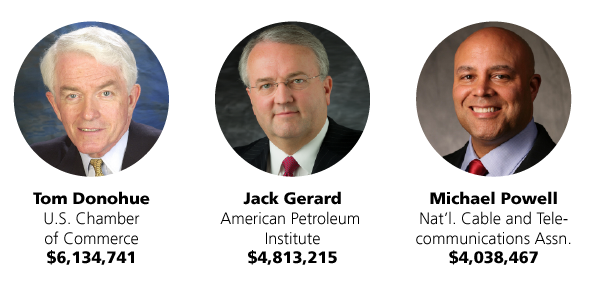Rising bonus targets driving large increase in CEO pay
Rising bonus targets driving large increase in CEO pay
- March 31, 2016 |
-
 CEO Update
CEO Update

At-risk compensation in corporate sector is filtering down to associations; public salary reports (like this one) also a factor
Related content
CEO Salaries at large associations 2016
Understanding this report
Beyond the chart
Bonuses drive salary increase for staffers
The highest-paid association executives continued to get richer, according to the latest CEO Update compensation survey, though at a bit lower rate than in the last report.
Base and bonus compensation for those already earning more than $1 million rose 7.8 percent versus 9.2 percent in last year's survey. For all association CEOs at groups with $12 million or more revenue, compensation increased 4.9 percent, the highest since the 5.2 percent observed in the 2013 analysis. Both sets of increases were driven by bonuses. Trade association chief executives' compensation rose 5.3 percent, versus 4.6 percent for professional society leaders.
Compensation expert Charlie Quatt of Quatt Associates said CEOs are being paid for performance and many of them are meeting their goals despite a difficult advocacy environment. But he questioned how long executive pay can advance at such a clip.

"One wonders how long the trend can continue, given the fact that annual revenues are not necessarily going up at the same level, and when you raise the compensation level for a CEO, there's a natural fallout sooner or later in how you pay (the staff) as well," Quatt said.
He credited (or blamed) CEO Update compensation surveys and other public reporting for the strong gains in association executive pay.
"Your publishing of information (and that by others) to a great extent is driving a lot of the compensation. These executives want to be paid like their peers and they will call me up and say, ‘You know, I just saw in CEO Update or someplace else, a list of the top 10 paid executives, why am I not one of them? I'm better than these people,'" Quatt said.
The survey also shows that despite its wide use for comparison purposes, median compensation should not be considered in isolation. In fact, median salary may be a lowball figure when compared with the salaries that the majority of CEOs earn.

When looking at compensation of the "middle 50 percent" of CEOs—those whose pay ranges from the 25th percentile to the 75th percentile—the median falls closer to the rear of the range.
That's especially true for trade associations, where the range from the median to the 75th percentile can be staggering: Median compensation for all trades was $652,000 in the latest survey, but at the 75th percentile, the pay was $1.2 million. At the 100th percentile was U.S. Chamber of Commerce CEO Tom Donohue, with more than $6 million in compensation (base salary and bonus).
In statistics and business, a bell curve like that is said to have a "long tail"—the extreme observations reach far from the top of the curve like a gently sloping hill. They are exceedingly rare but can have a big impact. Only one guy makes $6 mil, while the man at the median gets $652K.
(The man at the median in this year's report is Lawrence Farrell, the now-retired president of the $27 million-revenue National Defense Industrial Association. Ironically, his pay was previously much higher. His $652,024 compensation was all base salary—he did not receive his usual half-million dollar bonus in his final year.)
Stephanie Tomasso, head of the association practice at executive search firm Russell Reynolds Associates, said variations in the size of trade groups and in the importance of government advocacy to each group are driving the pay of executives in the higher percentiles.

The data show that you can make good money running a professional society—and great money representing corporations with big business in Washington, D.C.
The middle 50 percent of professional society CEOs earn from $336,000 at the 25th percentile to $583,000 at the 75th percentile. The bell curve is much steeper than that for trade associations, with the distribution more clustered in the middle. Compensation at the 75th percentile among professional society CEOs is half that of the 75th percentile of trade association CEOs.
Bonus targets up
The report shows the increasing impact of bonus pay, which rose much faster than base pay when looking at all association executives, though at a rate slower than that found in the 2013 report.
Quatt and Tomasso noted that bonus pay is becoming a bigger part of compensation for association executives, mirroring trends in business.
"We've seen bonus target percentages, when we are putting offers together, increase significantly," Tomasso said.
"Organizations that may have had less compensation at risk in the past are now looking at increasing" to be more in line with the corporate sector.
She declined to provide CEO Update with figures on the amount of at-risk pay she is seeing in executive contracts.
 Quatt said sophisticated performance scorecards are part of the story.
Quatt said sophisticated performance scorecards are part of the story.
"Our firm has been extensively engaged in developing performance metrics for CEOs, so it's no longer just ‘We think you did a good job,' but these men and women are really focused on performing, and they are performing, and they're getting rewarded for it."
Quatt declined to name names because of client confidentiality, but dramatic pay increases for some of the most prominent trade group CEOs illustrate Quatt's point.
According to data from the latest tax filings, base pay of Dawn Sweeney, CEO of $80 million-revenue National Restaurant Association, rose 15 percent. However, including bonus, her compensation jumped 91 percent.
Jay Timmons, CEO of $48 million-revenue National Association of Manufacturers, also saw base pay rise 15 percent but compensation including bonus surged 73 percent.
The CEO of $17 million-revenue NACHA—The Electronic Payments Association actually had base pay decline 0.2 percent. But Janet Estep's base plus bonus rose 50 percent.
